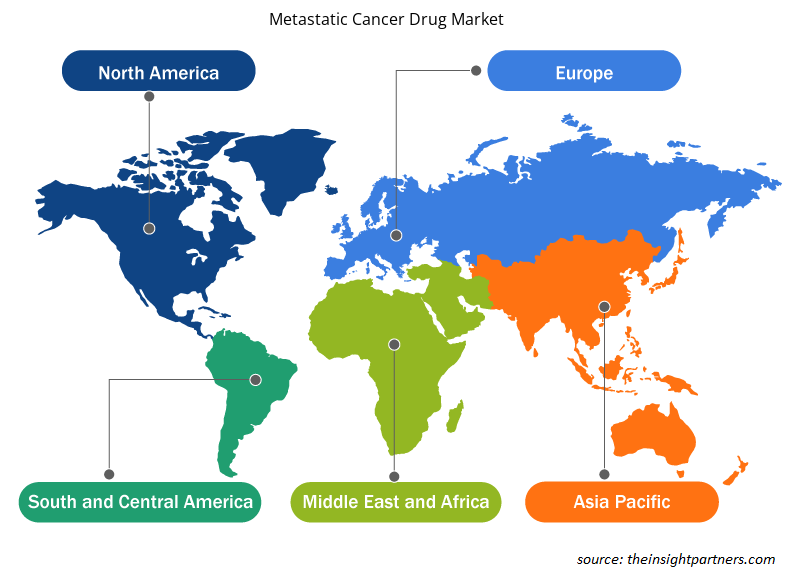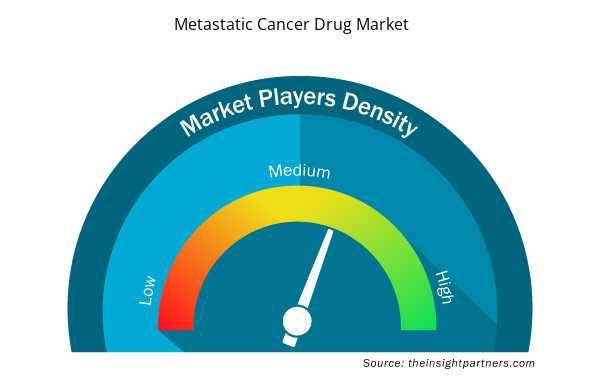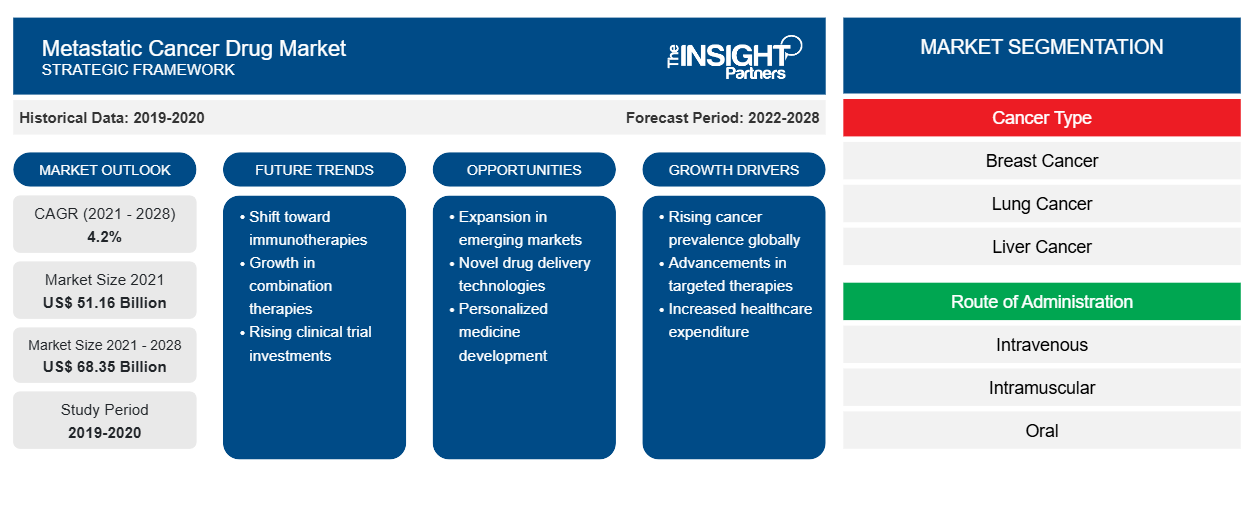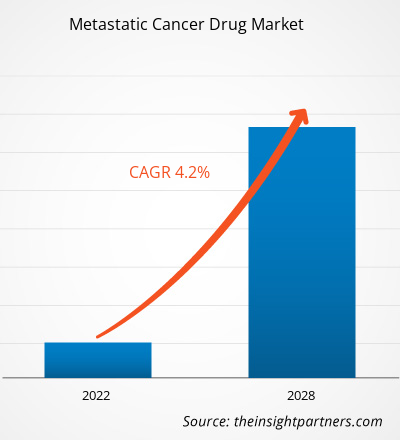[Rapport de recherche] La taille du marché des médicaments contre le cancer métastatique devrait atteindre 68 349,54 millions USD d'ici 2028, contre 51 157,97 millions USD en 2021. Il devrait croître à un TCAC de 4,2 % de 2021 à 2028.CAGR of 4.2% from 2021 to 2028.
Le cancer métastatique est défini comme un cancer à un stade avancé qui se propage à d'autres parties du corps. Les médicaments utilisés pour le traitement du cancer à un stade avancé sont appelés médicaments contre le cancer métastatique. Ces médicaments sont utilisés dans le cadre de diverses thérapies, telles que la chimiothérapie, l'immunothérapie et la thérapie ciblée. immunotherapy, and targeted therapy.
Le marché des médicaments contre le cancer métastatique est analysé en fonction du type de cancer, de la voie d'administration, de la classe de médicament, du produit, de l'utilisateur final et de la géographie. Le marché, par géographie, est largement segmenté en Amérique du Nord, Europe, Asie-Pacifique, Moyen-Orient et Afrique, et Amérique du Sud et centrale. Le rapport offre des informations et une analyse approfondie du marché, en mettant l'accent sur les paramètres tels que la taille du marché des médicaments contre le cancer métastatique, les tendances, les avancées technologiques et la dynamique du marché, ainsi que sur l'analyse du paysage concurrentiel des principaux acteurs du marché mondial.
Personnalisez ce rapport en fonction de vos besoins
Vous bénéficierez d'une personnalisation gratuite de n'importe quel rapport, y compris de certaines parties de ce rapport, d'une analyse au niveau des pays, d'un pack de données Excel, ainsi que d'offres et de remises exceptionnelles pour les start-ups et les universités.
- Obtenez les principales tendances clés du marché de ce rapport.Cet échantillon GRATUIT comprendra une analyse de données, allant des tendances du marché aux estimations et prévisions.
Le marché des médicaments contre le cancer métastatique est attribué à la prévalence élevée du cancer métastatique et aux initiatives gouvernementales visant à soutenir les progrès dans le traitement du cancer. Cependant, le coût élevé des médicaments oncologiques limite la croissance du marché des médicaments contre le cancer métastatique.
Informations sur le marché
Forte prévalence du cancer métastatique
Le cancer est l’un des problèmes de santé qui ont un impact significatif sur les sociétés du monde entier. Selon les données fournies par le National Institute of Cancer, en 2020, 1 806 590 personnes souffraient de cancer aux États-Unis tandis que 606 520 personnes en sont mortes. Selon l’American Institute of Cancer Research, en 2020, 18 100 cas étaient actifs dans le monde. En outre, l’Organisation mondiale de la santé (OMS) a déclaré que 10 000 décès, soit 1 décès sur 6 dans le monde, étaient dus au cancer. Les types de cancer les plus courants sont le cancer du poumon, le cancer du sein, le cancer du côlon, le cancer du rectum et le cancer de la prostate. Cette maladie se développe chez 400 000 enfants chaque année. Les infections cancérigènes, notamment Helicobacter pylori, le virus de l’hépatite B, le virus du papillome humain (VPH), le virus de l’hépatite C et le virus d’Epstein-Barr, ont causé 13 % des cas de cancer en 2018, dans le monde. Le Centre international de recherche sur le cancer (CIRC) prévoit que le nombre de nouveaux cas de cancer et de décès liés au cancer dans le monde augmentera de 1,6 à 1,7 fois d’ici 2040 pour atteindre 29,5 millions, contre 16,4 millions en 2018. En outre, selon l’American Society of Clinical Oncology, en 2021, 290 560 personnes (287 850 femmes et 2 710 hommes) aux États-Unis ont reçu un diagnostic de cancer du sein invasif. Le cancer du sein chez les femmes a désormais dépassé le cancer du poumon et est reconnu comme le type de cancer le plus courant dans le monde. Environ 2 261 419 femmes ont reçu un diagnostic de cancer du sein en 2020.papillomavirus (HPV), hepatitis C virus, and Epstein-Barr virus—caused 13% of cancer cases in 2018, globally. The International Agency for Research on Cancer (IARC) projects that the number of new cancer cases and cancer-related deaths worldwide will grow 1.6–1.7 fold by 2040 to reach 29.5 million and from 16.4 million in 2018. Further, according to the American Society of Clinical Oncology, in 2021, 290,560 people (287,850 women and 2,710 men) in the US were diagnosed with invasive breast cancer. Breast cancer in females has now surpassed lung cancer and is recognized as the most common cancer type worldwide. Approximately, 2,261,419 women were diagnosed with breast cancer in 2020.
Parmi toutes les observations sur le cancer enregistrées aux États-Unis au cours des dernières décennies, une statistique n’a pas changé : le cancer métastatique est responsable de 90 % des décès par cancer chaque année. Ces chiffres ont incité les médecins et les chercheurs à trouver de nouvelles façons de traiter les métastases, qui surviennent lorsque le cancer se propage au-delà de son point d’origine. Aux États-Unis, 6 % des femmes ont reçu un diagnostic de cancer du sein métastatique lors du premier diagnostic. Une telle augmentation de la prévalence du cancer métastatique stimule la croissance du marché des médicaments contre le cancer métastatique.
En Amérique du Nord, le Canada devrait connaître une croissance considérable au cours de la période de prévision. Les principaux médicaments d'immunothérapie utilisés au Canada sont l'ipilimumab (Yervoy), le pembrolizumab (Keytruda), le nivolumab (Opdivo), le durvalumab (Imfinzi) et l'atezolizumab (Tecentriq). Cependant, d'autres inhibiteurs de points de contrôle sont sur le point de stimuler la croissance globale du marché.immunotherapy drugs used in Canada are ipilimumab (Yervoy), pembrolizumab (Keytruda), nivolumab (Opdivo), durvalumab (Imfinzi) and atezolizumab (Tecentriq). However, there are other checkpoint inhibitors poised to bring the overall market growth.
Informations basées sur le type de cancer
En fonction du type de cancer, le marché des médicaments contre le cancer métastatique est segmenté en cancer du sein, cancer du poumon, cancer du foie , cancer hématologique , cancer du cerveau, cancer de la prostate, cancer du pancréas et autres. Le segment du cancer du sein représentait la plus grande part de marché en 2021 et devrait enregistrer le TCAC le plus élevé au cours de la période de prévision.CAGR during the forecast period.
Informations basées sur la voie d'administration
En fonction de la voie d'administration, le marché des médicaments contre le cancer métastatique est segmenté en intraveineux, intramusculaire, oral et autres. Le segment intraveineux représentait la plus grande part de marché en 2021 et devrait enregistrer le TCAC le plus élevé au cours de la période de prévision.CAGR during the forecast period.
Informations basées sur les classes de médicaments
En fonction de la classe de médicaments, le marché des médicaments contre le cancer métastatique est segmenté en inhibiteurs de HER2, inhibiteurs de points de contrôle immunitaires , inhibiteurs de PARP, inhibiteurs de kinase et autres. Le segment des inhibiteurs de PARP représentait la plus grande part de marché en 2021. Cependant, le segment des inhibiteurs de HER2 devrait enregistrer le TCAC le plus élevé au cours de la période de prévision.CAGR during the forecast period.
Aperçu régional du marché des médicaments contre le cancer métastatique
Les tendances et facteurs régionaux influençant le marché des médicaments contre le cancer métastatique tout au long de la période de prévision ont été expliqués en détail par les analystes d’Insight Partners. Cette section traite également des segments et de la géographie du marché des médicaments contre le cancer métastatique en Amérique du Nord, en Europe, en Asie-Pacifique, au Moyen-Orient et en Afrique, ainsi qu’en Amérique du Sud et en Amérique centrale.

- Obtenez les données régionales spécifiques au marché des médicaments contre le cancer métastatique
Portée du rapport sur le marché des médicaments contre le cancer métastatique
| Attribut de rapport | Détails |
|---|---|
| Taille du marché en 2021 | 51,16 milliards de dollars américains |
| Taille du marché d'ici 2028 | 68,35 milliards de dollars américains |
| Taux de croissance annuel moyen mondial (2021-2028) | 4,2% |
| Données historiques | 2019-2020 |
| Période de prévision | 2022-2028 |
| Segments couverts | Par type de cancer
|
| Régions et pays couverts | Amérique du Nord
|
| Leaders du marché et profils d'entreprises clés |
|
Densité des acteurs du marché des médicaments contre le cancer métastatique : comprendre son impact sur la dynamique commerciale
Le marché des médicaments contre le cancer métastatique connaît une croissance rapide, tirée par la demande croissante des utilisateurs finaux en raison de facteurs tels que l'évolution des préférences des consommateurs, les avancées technologiques et une plus grande sensibilisation aux avantages du produit. À mesure que la demande augmente, les entreprises élargissent leurs offres, innovent pour répondre aux besoins des consommateurs et capitalisent sur les tendances émergentes, ce qui alimente davantage la croissance du marché.
La densité des acteurs du marché fait référence à la répartition des entreprises ou des sociétés opérant sur un marché ou un secteur particulier. Elle indique le nombre de concurrents (acteurs du marché) présents sur un marché donné par rapport à sa taille ou à sa valeur marchande totale.
Les principales entreprises opérant sur le marché des médicaments contre le cancer métastatique sont :
- AbbVie Inc.
- Amgen Inc.
- Société Bristol-Myers Squibb
- F. HOFFMANN-LA ROCHE LTÉE.
- Novartis SA
Avis de non-responsabilité : les sociétés répertoriées ci-dessus ne sont pas classées dans un ordre particulier.

- Obtenez un aperçu des principaux acteurs clés du marché des médicaments contre le cancer métastatique
Informations basées sur les produits
En fonction du produit, le marché des médicaments contre le cancer métastatique est divisé en médicaments de marque, génériques et biosimilaires. Le segment des médicaments de marque représentait une part de marché plus importante en 2021. Cependant, le segment des génériques et des biosimilaires devrait enregistrer un TCAC plus élevé au cours de la période de prévision.
Informations basées sur l'utilisateur final
En fonction de l'utilisateur final, le marché des médicaments contre le cancer métastatique est segmenté en hôpitaux, cliniques spécialisées et autres. Le segment des hôpitaux représentait la plus grande part en 2021, tandis que le segment des cliniques spécialisées devrait enregistrer le TCAC le plus élevé au cours de la période de prévision.
Les lancements et les approbations de produits font partie des stratégies couramment adoptées par les entreprises pour étendre leur présence mondiale et leurs portefeuilles de produits. Les acteurs du marché des médicaments contre le cancer métastatique se concentrent également sur la stratégie de partenariat pour élargir leur clientèle, ce qui leur permet à son tour de maintenir leur nom de marque à travers le monde. Ils visent à accroître leurs parts de marché grâce au développement de produits innovants.
AbbVie Inc. ; Amgen Inc. ; Bristol-Myers Squibb Company ; F. HOFFMANN-LA ROCHE LTD. ; Novartis AG ; ASTRAZENECA PLC. ; Eli Lilly and Company ; MERCK KGaA ; et Pfizer Inc. (Arena Pharmaceutical GmbH) ; et Johnson and Johnson Services, Inc. sont les principales sociétés opérant sur le marché des médicaments contre le cancer métastatique.
- Analyse historique (2 ans), année de base, prévision (7 ans) avec TCAC
- Analyse PEST et SWO
- Taille du marché Valeur / Volume - Mondial, Régional, Pays
- Industrie et paysage concurrentiel
- Ensemble de données Excel



Report Coverage
Revenue forecast, Company Analysis, Industry landscape, Growth factors, and Trends

Segment Covered
This text is related
to segments covered.

Regional Scope
North America, Europe, Asia Pacific, Middle East & Africa, South & Central America

Country Scope
This text is related
to country scope.
Questions fréquemment posées
Cancer that spreads from where it started to a distant part of the body is called metastatic cancer. The process by which cancer cells spread to other parts of the body is called metastasis. Metastatic cancer is an advanced cancer stage that spread to the other body parts and the drugs used for the treatment of advanced stage cancer are known as metastatic cancer drugs. These drugs are used through various therapies such as chemotherapy, immunotherapy, and targeted therapy.
The factors that are driving and restraining factors that will affect the metastatic cancer drugs market in the coming years. The growth of the market is attributed to some key driving factors such as increasing prevalence of cancer and government initiatives to support drug developments for cancer treatment. However, high cost of oncology drugs is likely to hinder the market growth.
The metastatic cancer drug market, by cancer type, is bifurcated into breast cancer, lung cancer, liver cancer, hematological cancer, brain cancer, prostate cancer, pancreatic cancer, and others. The breast cancer segment held the largest share in 2021 and is anticipated to register the highest CAGR during the forecast period.
The metastatic cancer drug market majorly consists of the players such as AbbVie Inc., Amgen Inc., Bristol-Myers Squibb Company, F. HOFFMANN-LA ROCHE LTD., Novartis AG, ASTRAZENECA PLC., Eli Lilly and Company, MERCK KGaA, and Pfizer Inc. (Arena Pharmaceutical GmbH) amongst others.
Trends and growth analysis reports related to Life Sciences : READ MORE..
The List of Companies - Metastatic Cancer Drug Market
- AbbVie Inc.
- Amgen Inc.
- Bristol-Myers Squibb Company
- F. HOFFMANN-LA ROCHE LTD.
- Novartis AG
- ASTRAZENECA PLC.
- Eli Lilly and Company
- MERCK KGaA
- Pfizer Inc. (Arena Pharmaceutical GmbH)
The Insight Partners performs research in 4 major stages: Data Collection & Secondary Research, Primary Research, Data Analysis and Data Triangulation & Final Review.
- Data Collection and Secondary Research:
As a market research and consulting firm operating from a decade, we have published and advised several client across the globe. First step for any study will start with an assessment of currently available data and insights from existing reports. Further, historical and current market information is collected from Investor Presentations, Annual Reports, SEC Filings, etc., and other information related to company’s performance and market positioning are gathered from Paid Databases (Factiva, Hoovers, and Reuters) and various other publications available in public domain.
Several associations trade associates, technical forums, institutes, societies and organization are accessed to gain technical as well as market related insights through their publications such as research papers, blogs and press releases related to the studies are referred to get cues about the market. Further, white papers, journals, magazines, and other news articles published in last 3 years are scrutinized and analyzed to understand the current market trends.
- Primary Research:
The primarily interview analysis comprise of data obtained from industry participants interview and answers to survey questions gathered by in-house primary team.
For primary research, interviews are conducted with industry experts/CEOs/Marketing Managers/VPs/Subject Matter Experts from both demand and supply side to get a 360-degree view of the market. The primary team conducts several interviews based on the complexity of the markets to understand the various market trends and dynamics which makes research more credible and precise.
A typical research interview fulfils the following functions:
- Provides first-hand information on the market size, market trends, growth trends, competitive landscape, and outlook
- Validates and strengthens in-house secondary research findings
- Develops the analysis team’s expertise and market understanding
Primary research involves email interactions and telephone interviews for each market, category, segment, and sub-segment across geographies. The participants who typically take part in such a process include, but are not limited to:
- Industry participants: VPs, business development managers, market intelligence managers and national sales managers
- Outside experts: Valuation experts, research analysts and key opinion leaders specializing in the electronics and semiconductor industry.
Below is the breakup of our primary respondents by company, designation, and region:

Once we receive the confirmation from primary research sources or primary respondents, we finalize the base year market estimation and forecast the data as per the macroeconomic and microeconomic factors assessed during data collection.
- Data Analysis:
Once data is validated through both secondary as well as primary respondents, we finalize the market estimations by hypothesis formulation and factor analysis at regional and country level.
- Macro-Economic Factor Analysis:
We analyse macroeconomic indicators such the gross domestic product (GDP), increase in the demand for goods and services across industries, technological advancement, regional economic growth, governmental policies, the influence of COVID-19, PEST analysis, and other aspects. This analysis aids in setting benchmarks for various nations/regions and approximating market splits. Additionally, the general trend of the aforementioned components aid in determining the market's development possibilities.
- Country Level Data:
Various factors that are especially aligned to the country are taken into account to determine the market size for a certain area and country, including the presence of vendors, such as headquarters and offices, the country's GDP, demand patterns, and industry growth. To comprehend the market dynamics for the nation, a number of growth variables, inhibitors, application areas, and current market trends are researched. The aforementioned elements aid in determining the country's overall market's growth potential.
- Company Profile:
The “Table of Contents” is formulated by listing and analyzing more than 25 - 30 companies operating in the market ecosystem across geographies. However, we profile only 10 companies as a standard practice in our syndicate reports. These 10 companies comprise leading, emerging, and regional players. Nonetheless, our analysis is not restricted to the 10 listed companies, we also analyze other companies present in the market to develop a holistic view and understand the prevailing trends. The “Company Profiles” section in the report covers key facts, business description, products & services, financial information, SWOT analysis, and key developments. The financial information presented is extracted from the annual reports and official documents of the publicly listed companies. Upon collecting the information for the sections of respective companies, we verify them via various primary sources and then compile the data in respective company profiles. The company level information helps us in deriving the base number as well as in forecasting the market size.
- Developing Base Number:
Aggregation of sales statistics (2020-2022) and macro-economic factor, and other secondary and primary research insights are utilized to arrive at base number and related market shares for 2022. The data gaps are identified in this step and relevant market data is analyzed, collected from paid primary interviews or databases. On finalizing the base year market size, forecasts are developed on the basis of macro-economic, industry and market growth factors and company level analysis.
- Data Triangulation and Final Review:
The market findings and base year market size calculations are validated from supply as well as demand side. Demand side validations are based on macro-economic factor analysis and benchmarks for respective regions and countries. In case of supply side validations, revenues of major companies are estimated (in case not available) based on industry benchmark, approximate number of employees, product portfolio, and primary interviews revenues are gathered. Further revenue from target product/service segment is assessed to avoid overshooting of market statistics. In case of heavy deviations between supply and demand side values, all thes steps are repeated to achieve synchronization.
We follow an iterative model, wherein we share our research findings with Subject Matter Experts (SME’s) and Key Opinion Leaders (KOLs) until consensus view of the market is not formulated – this model negates any drastic deviation in the opinions of experts. Only validated and universally acceptable research findings are quoted in our reports.
We have important check points that we use to validate our research findings – which we call – data triangulation, where we validate the information, we generate from secondary sources with primary interviews and then we re-validate with our internal data bases and Subject matter experts. This comprehensive model enables us to deliver high quality, reliable data in shortest possible time.


 Obtenez un échantillon gratuit pour ce rapport
Obtenez un échantillon gratuit pour ce rapport